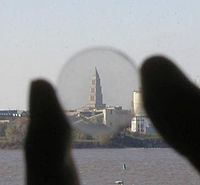
Photo from wikipedia
Abstract Vanadium dioxide (VO2) thin films have significant attention as thermochromic layers since they present an attracted modification of optical transmission in the near-infrared region while remaining transparent. A solution… Click to show full abstract
Abstract Vanadium dioxide (VO2) thin films have significant attention as thermochromic layers since they present an attracted modification of optical transmission in the near-infrared region while remaining transparent. A solution processing method is convenient and cost-efficient for the fabrication of VO2 films, however, this method requires high-temperature and long-time thermal reduction and post annealing to obtain highly crystallized VO2 films. Thermal and intense pulsed light (IPL) annealing are employed in order to compare the microstructural evolution, thermochromic properties and their feasibility for fabrication of VO2 nanoparticle-based films. A remarkable improvement in visible transmittance and thermochromic property of VO2 nanoparticle ink films has been achieved by intense pulsed light (IPL) irradiation compared to thermal annealing: the VO2 films IPL annealed with 400 pulses have decent visible light transmittance (Tvis) of 55.2% at 550 nm, excellent infrared modulation at 2000 nm (ΔT2000 nm) of 45.2%, and salient solar modulation efficiency (ΔTsol) of 9.2% while those thermally annealed at 600 °C show Tvis of 24.3%, ΔT2000 nm of 20.9% and ΔTsol of 5.0%. These results indicate that IPL irradiation could open an efficient way to fabricate VO2 nanoparticle-based films and solution-processed thermochromic smart windows.
Journal Title: Applied Surface Science
Year Published: 2019
Link to full text (if available)
Share on Social Media: Sign Up to like & get
recommendations!